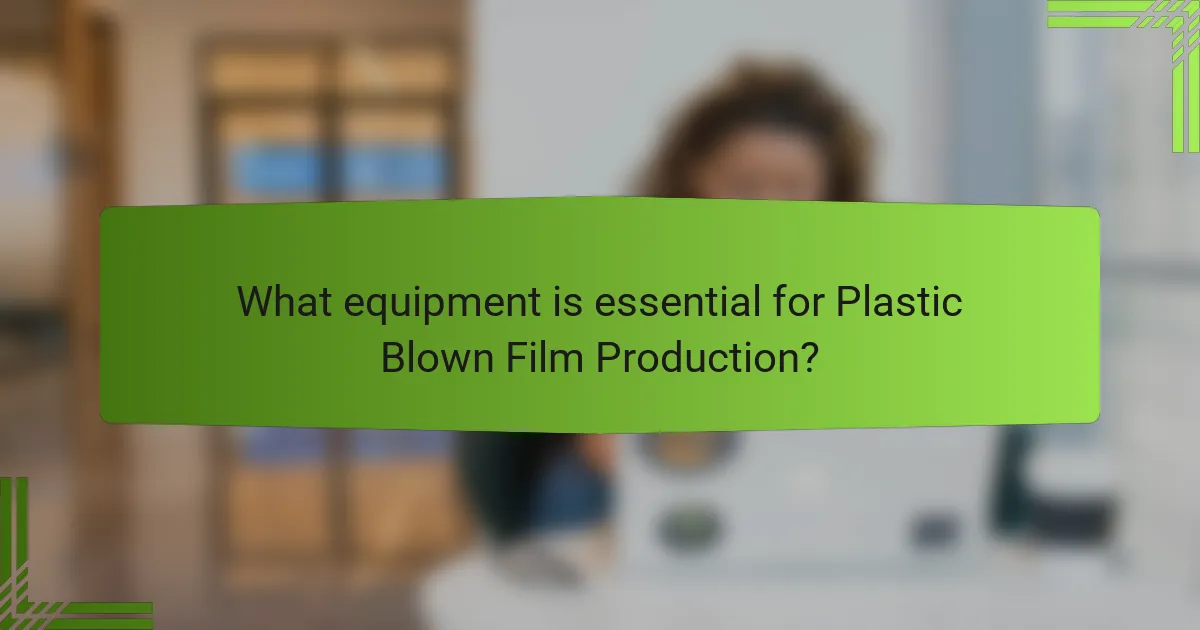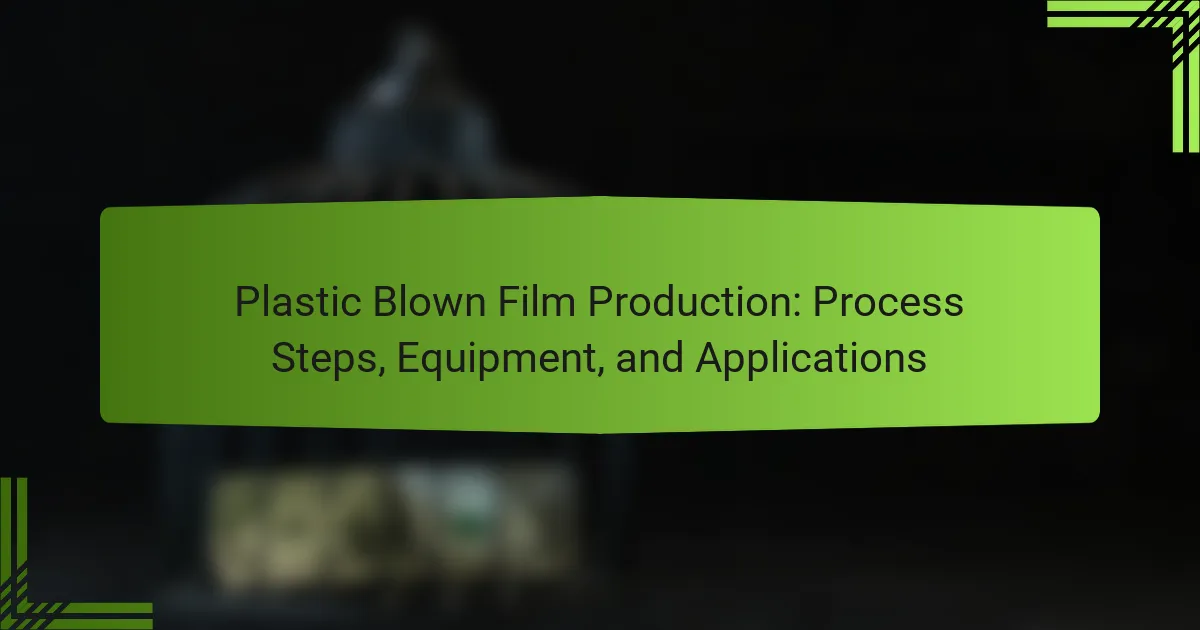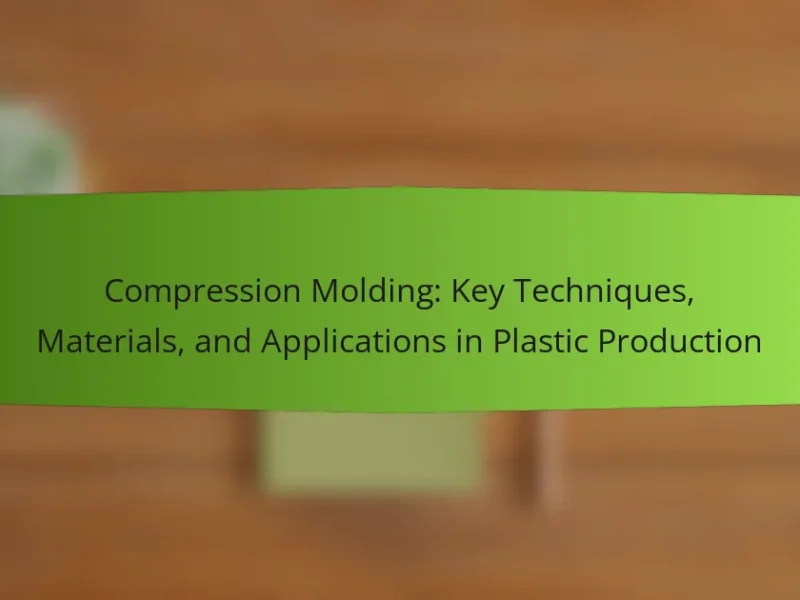Plastic blown film production is a manufacturing process that creates thin plastic films through the extrusion of melted plastic resin into a tubular shape, which is then inflated and cooled. This technique is essential for producing flexible packaging materials used across various industries, including packaging, agriculture, and construction. Key equipment involved in this process includes an extruder, die, cooling system, and take-up system, each contributing to the efficient production of high-quality films. Plastic blown films are widely utilized for applications such as grocery bags, food packaging, and agricultural films, offering moisture protection and durability, with the global plastic film market valued at approximately $100 billion in 2020.

What is Plastic Blown Film Production?
Plastic blown film production is a manufacturing process used to create thin plastic films. This technique involves melting plastic resin and extruding it through a circular die to form a tube. The tube is then inflated and cooled to form a film. The process allows for the production of flexible packaging materials. It is widely used in industries for packaging, agriculture, and construction. The blown film process can produce films of varying thickness and strength. Additionally, it enables the incorporation of additives for specific properties. This method is efficient and cost-effective for large-scale production.
How does the Plastic Blown Film Production process work?
The plastic blown film production process involves extruding plastic resin into a tube and then inflating it. The process begins with the melting of plastic pellets in an extruder. The molten plastic is then forced through a circular die to form a thin tube. Air is introduced into the tube to expand it, creating a film. The film is cooled and solidified as it is drawn upward. It is then flattened and wound onto rolls. This method allows for continuous production of thin plastic sheets. The resulting films are used in packaging, agricultural applications, and more.
What are the key stages involved in the Plastic Blown Film Production process?
The key stages in the Plastic Blown Film Production process include extrusion, blowing, cooling, and winding. In the extrusion stage, plastic resin is melted and formed into a tube. This tube is then inflated in the blowing stage to achieve the desired thickness and diameter. During the cooling stage, the film is cooled to solidify its structure. Finally, in the winding stage, the film is rolled onto a core for storage and distribution. Each stage is essential for ensuring the quality and consistency of the final product.
What materials are used in Plastic Blown Film Production?
The primary materials used in plastic blown film production are polyethylene resins, particularly low-density polyethylene (LDPE) and linear low-density polyethylene (LLDPE). These materials are favored for their flexibility, strength, and durability. Polypropylene (PP) is also used for specific applications due to its excellent barrier properties. Additives such as slip agents and anti-block agents are incorporated to enhance film performance. Colorants may be added to achieve specific visual characteristics. The materials are selected based on the desired film properties and end-use applications.
What are the benefits of Plastic Blown Film Production?
Plastic blown film production offers several key benefits. It enables the creation of lightweight and flexible packaging materials. These materials are often used in food packaging, agricultural films, and industrial applications. The process allows for high production speeds, resulting in cost efficiency. Additionally, blown films can achieve varying thicknesses, enhancing versatility. The method also provides excellent barrier properties, protecting contents from moisture and contaminants. Furthermore, the production process minimizes waste, contributing to sustainability. Overall, plastic blown film production is crucial for efficient, high-quality packaging solutions.
How does Plastic Blown Film Production contribute to sustainability?
Plastic blown film production contributes to sustainability by utilizing recyclable materials and reducing waste. The process often incorporates recycled polyethylene, minimizing reliance on virgin plastics. This approach lowers carbon emissions during production. Additionally, advancements in technology enhance energy efficiency in manufacturing. For example, newer machines consume less energy while maintaining production quality. The use of thinner films also reduces plastic consumption without compromising strength. These practices collectively support environmental sustainability by promoting resource conservation and minimizing ecological impact.
What advantages does Plastic Blown Film Production offer over other methods?
Plastic blown film production offers several advantages over other methods. It allows for the creation of films with uniform thickness and excellent mechanical properties. This process enables high production speeds, making it efficient for large-scale manufacturing. Additionally, blown films exhibit superior strength and flexibility compared to cast films. The method also provides better barrier properties, which are crucial for packaging applications. Furthermore, blown film production can accommodate a variety of resin types, enhancing versatility. This adaptability makes it suitable for various industries, including food packaging and agricultural films. Overall, these advantages contribute to the widespread use of plastic blown film production in the market.

What equipment is essential for Plastic Blown Film Production?
The essential equipment for Plastic Blown Film Production includes an extruder, a die, and a cooling system. The extruder melts and shapes the plastic resin into a continuous film. The die forms the molten plastic into a tubular shape. A cooling system is necessary to solidify the film as it exits the die. Additionally, a take-up system collects the finished film for further processing. Each piece of equipment plays a critical role in producing high-quality plastic films. The combination of these components ensures efficient and effective film production.
What are the main types of machinery used in Plastic Blown Film Production?
The main types of machinery used in Plastic Blown Film Production are extruders, cooling rings, and winders. Extruders melt and shape plastic resin into a tubular film. Cooling rings help to solidify the film as it is formed. Winders collect the finished film into rolls for storage and distribution. These machines work together to create high-quality plastic films efficiently. Each type of machinery plays a crucial role in the production process, ensuring the film meets specific thickness and quality standards.
How does each type of machinery function in the production process?
Extrusion machinery melts plastic pellets and forces them through a die to form a continuous tube. This tube is then inflated with air to create a bubble, which is cooled and solidified. The cooling process stabilizes the film structure. Next, the film is flattened and wound onto rolls for further processing. Printing and cutting machinery applies designs and trims the film to desired lengths. Each type of machinery plays a crucial role in ensuring the quality and efficiency of the production process. For instance, the extrusion process can achieve film thicknesses ranging from 0.5 to 10 mils, demonstrating its versatility.
What are the specifications for the key equipment in Plastic Blown Film Production?
The key equipment in Plastic Blown Film Production includes extruders, blowers, and cooling rings. Extruders typically have a diameter ranging from 30 mm to 120 mm. They operate at temperatures between 180°C and 240°C. Blowers are used to create a bubble and generally operate at pressures of 0.5 to 1.5 bar. Cooling rings maintain a temperature of around 20°C to 30°C to solidify the film. Winding units align film rolls at a tension of 1 to 3 kg. Each piece of equipment must meet specific standards for efficiency and safety. These specifications ensure optimal film quality and production efficiency.
What role do auxiliary equipment and tools play in Plastic Blown Film Production?
Auxiliary equipment and tools are essential in Plastic Blown Film Production. They enhance the efficiency and quality of the production process. Tools such as chillers control the temperature of the extruded film. This ensures proper cooling and solidification. Additionally, air rings help maintain the film’s thickness and uniformity. They provide consistent airflow around the film bubble. Other equipment, like film winders, facilitate the collection and storage of the finished product. These machines automate winding, reducing labor costs and errors. Furthermore, quality control tools monitor film properties during production. This ensures adherence to specifications and standards. Overall, auxiliary equipment and tools are vital for optimizing production and maintaining quality.
What types of auxiliary equipment are commonly used?
Common types of auxiliary equipment used in plastic blown film production include chill rolls, air rings, and die heaters. Chill rolls cool the film after it is extruded, ensuring proper thickness and quality. Air rings provide a controlled airflow to stabilize the film bubble during production. Die heaters maintain the temperature of the die, ensuring consistent material flow. Additional auxiliary equipment can include film winders and edge trimmers. These devices enhance efficiency and quality in the production process. Each piece of equipment plays a vital role in achieving optimal film characteristics.
How do auxiliary tools enhance the efficiency of the production process?
Auxiliary tools enhance the efficiency of the production process by optimizing workflow and reducing downtime. These tools include devices like conveyors, chillers, and automatic feeders. They streamline material handling, ensuring consistent input of raw materials. For instance, conveyors minimize manual labor and speed up transport between production stages. Chillers maintain optimal temperatures for materials, preventing defects. Automatic feeders ensure precise material delivery, reducing waste. Research shows that integrating auxiliary tools can lead to a 20-30% increase in production efficiency. This is evidenced by case studies in plastic manufacturing where auxiliary systems were implemented.

What applications utilize Plastic Blown Film?
Plastic blown film is utilized in various applications, primarily for packaging. Common uses include grocery bags, food packaging, and industrial liners. These films provide moisture protection and durability. They are also employed in agricultural films for crop protection. The versatility of plastic blown film allows for customization in thickness and strength. Additionally, it is used in shrink films and stretch films for pallet wrapping. The global plastic film market was valued at approximately $100 billion in 2020, highlighting its widespread adoption.
What industries primarily use Plastic Blown Film?
The industries that primarily use plastic blown film include packaging, agriculture, and construction. The packaging industry utilizes blown film for bags, wraps, and pouches. In agriculture, it is used for greenhouse covers and mulch films. The construction industry employs blown film for vapor barriers and protective coverings. These applications highlight the versatility and importance of plastic blown film across various sectors.
How is Plastic Blown Film applied in packaging solutions?
Plastic blown film is widely applied in packaging solutions due to its versatility and strength. It is utilized to create bags, wraps, and liners that protect products. The film’s lightweight nature reduces shipping costs. Its moisture barrier properties help preserve food and other perishable goods. Additionally, plastic blown film can be printed on, allowing for branding and product information. The production process ensures uniform thickness and durability across the film. This consistency enhances the film’s performance in various packaging applications. Overall, plastic blown film is essential for efficient and effective packaging solutions across multiple industries.
What are some innovative uses of Plastic Blown Film in various sectors?
Plastic blown film is used innovatively in packaging, agriculture, and construction sectors. In packaging, it provides durable and lightweight solutions for food products, enhancing shelf life. The agricultural sector utilizes plastic blown film for greenhouse covers, promoting plant growth while conserving energy. In construction, it serves as vapor barriers and protective covers, ensuring material integrity. The versatility of plastic blown film contributes to its widespread adoption across these industries, showcasing its adaptability and efficiency.
What are the trends shaping the future of Plastic Blown Film applications?
Sustainability and eco-friendly materials are key trends shaping the future of plastic blown film applications. The demand for biodegradable and recyclable films is increasing. Many manufacturers are investing in sustainable production processes. Innovations in materials, such as bio-based polymers, are becoming more prevalent. Additionally, advancements in technology are enhancing film performance and reducing production waste. The growth of e-commerce is driving the need for durable packaging solutions. Customization and flexibility in film design are also on the rise. These trends reflect a shift towards more responsible and efficient use of plastic materials.
How is technology influencing the development of new applications?
Technology is significantly influencing the development of new applications in plastic blown film production. Innovations in equipment, such as advanced extrusion and cooling systems, enhance efficiency. Improved software for process monitoring allows for real-time adjustments, increasing product quality. Automation in material handling reduces labor costs and errors. New materials, including biodegradable options, are being integrated into applications. Research indicates that these advancements lead to more sustainable production methods. Consequently, the industry is adapting to changing consumer demands and regulatory requirements.
What are the emerging markets for Plastic Blown Film?
Emerging markets for plastic blown film include Asia-Pacific, Latin America, and Africa. The Asia-Pacific region is experiencing rapid industrial growth. Countries like India and China are increasing demand for packaging solutions. Latin America shows growth due to rising consumer goods sectors. Brazil and Mexico are significant contributors to this trend. Africa’s emerging economies are also expanding their packaging industries. Increased urbanization and population growth drive this demand. These markets are expected to grow significantly in the coming years.
What best practices should be followed in Plastic Blown Film Production?
Best practices in plastic blown film production include selecting high-quality resins. Using the right resin enhances film properties. Maintaining consistent processing temperatures is crucial for uniformity. Regularly calibrating equipment ensures optimal performance. Implementing quality control measures monitors film thickness and gauge. Properly training operators improves efficiency and reduces errors. Utilizing efficient cooling systems prevents defects in film. Lastly, recycling scrap material minimizes waste and reduces costs.
Plastic blown film production is a manufacturing process that creates thin plastic films through the extrusion and inflation of melted plastic resin. This article details the steps involved in the process, including extrusion, blowing, cooling, and winding, as well as the essential machinery and auxiliary equipment used. It explores the materials utilized, the benefits of the production method, and its contributions to sustainability. Additionally, the article highlights various applications across industries such as packaging, agriculture, and construction, while discussing emerging trends and best practices in the field.


